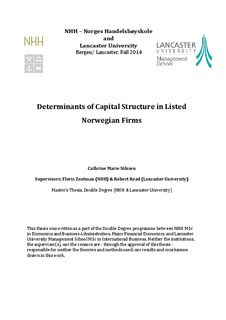Determinants of Capital Structure in Listed Norwegian Firms
Master thesis
Permanent lenke
http://hdl.handle.net/11250/281628Utgivelsesdato
2014Metadata
Vis full innførselSamlinger
- Master Thesis [4372]
Sammendrag
The main goal for most firms is to maximise firm value and the wealth of shareholders.
In order to achieve this goal, firms should use an optimal combination of equity and
debt that will result in a low weighted average cost of capital for the firm. It is therefore
necessary for firms to be aware of the factors that influence their capital structure decision.
Several empirical studies have attempted to explain what determines the choice of
capital structure in firms. However few have focused solely on Norwegian firms. Hence,
the primary objective of this study is to examine what determines the capital structure
in listed Norwegian firms.DataStream was used to obtain the data needed for the statistical analysis and previous studies were used to calculate the measures for the firm-specific characteristics. The
study was conducted over a period of 7 years, from 2007 to 2013, and there were a
total of 90 firms in the sample, resulting in 876 observations.
The results from the study indicate that tangibility is the most important firm
characteristic to consider when making capital structure decisions. Furthermore, the
results indicate a difference between the book value and market value of debt. Book
value of leverage finds support in the pecking order theory, while none of the theories
fully explains the observed capital structure in Norwegian firms. Based on the evidence
obtained from this research, firms should take these firm-specific factors into account
when making capital structure decisions.
